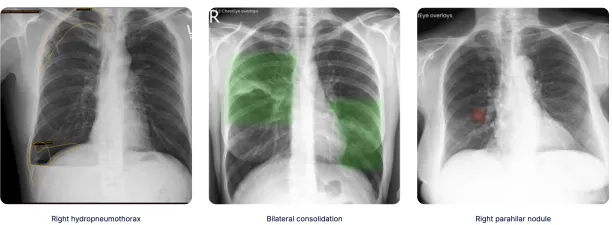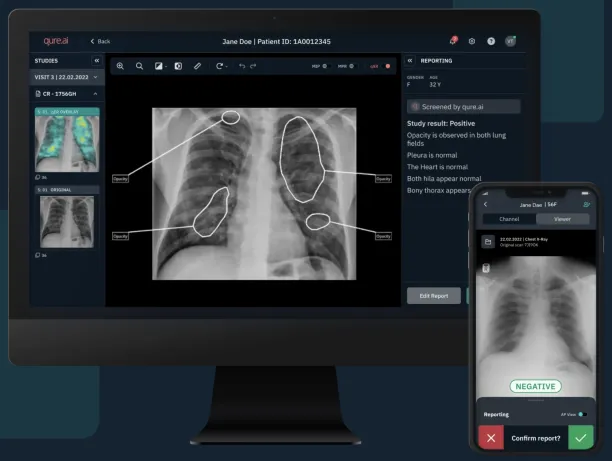The integration of artificial intelligence (AI) to radiology is not a futuristic vision; it’s already redefining clinical workflows, particularly in X-ray imaging.
AI tools are now embedded into imaging systems, enabling real-time decision support and improving workflow efficiency, image quality, and clinical accuracy. With global imaging demands rising, driven by chronic illnesses and aging populations, XRay AI applications offer a response to the evolving needs of healthcare professionals.
Discover how AI tools can advance X-ray and medical imaging analysis, their use cases, and real-life examples.
How X-ray AI works
AI algorithms in medical imaging function by analyzing X-ray images using deep learning techniques such as convolutional neural networks (CNNs). These models are trained on large datasets of annotated ray images to identify patterns that may indicate conditions such as pneumonia, pneumothorax, or lung cancer. Once trained, these models can process new images, prioritize them based on urgency, and assist radiologists in their diagnostic process.
Unlike rule-based systems, modern AI models are capable of learning from data patterns and improving over time. When integrated into clinical infrastructure, such as PACS (Picture Archiving and Communication Systems), they support radiologists by flagging abnormalities, optimizing scan protocols, or even generating near-complete reports.
First is the training phase:
- Data collection: Thousands to millions of chest X-rays or other radiographs are collected. Experienced radiologists usually label these images to indicate the presence or absence of specific conditions.
- Feature learning: The AI system learns relevant features, such as texture, edge sharpness, or shape patterns, from the labeled data.
- Model tuning: Through supervised learning, the model adjusts its internal parameters to maximize predictive performance (e.g., minimizing false negatives in detecting a pneumothorax).
- Validation: The model is evaluated on new data to assess its generalizability, using metrics such as sensitivity, specificity, AUC, and precision.
How AI processes new images
Once trained, the AI model is embedded into clinical infrastructure, such as a mobile X-ray imaging system or PACS. Here’s how the process unfolds in real-world clinical workflows:
- Image acquisition:
- During a scan, on-device AI can immediately assess image quality, detecting clipped fields, incorrect patient positioning, or artifacts.
- Image analysis:
- After the acquisition, the AI analyzes the X-ray images using trained pattern recognition models.
- The system scans for markers of specific diseases (e.g., air pockets for pneumothorax, nodular opacity for tuberculosis) and generates a probability score for each finding.
- Triage and alerting:
- If a critical abnormality is suspected, the AI can flag the case and send an alert to the PACS.
- This elevates the image to the top of a radiologist’s reading list, enabling prioritized interpretation.
AI deployment models
There are different ways X-ray AI is implemented, including:
- On-device AI: Embedded directly into X-ray equipment for real-time use, enhancing workflow efficiency at the point of care.
- Cloud-based solutions: Images are uploaded to the cloud for analysis using more computationally intensive AI models.
- Platform-based systems: Some vendors offer marketplaces of AI tools integrated into hospital systems, enabling easy deployment and switching between AI algorithms depending on the clinical context.
Types of tasks performed
- Classification: Detecting the presence of conditions like lung cancer, pleural effusion, or tuberculosis.
- Segmentation: Identifying specific regions in an image (e.g., marking a pneumothorax boundary).
- Regression: Estimating values such as lesion size or progression rates.
- Report summarization: Drafting structured clinical reports from AI findings.
Performance monitoring and learning
Modern X-ray AI systems can adapt through continuous learning. When appropriately integrated, these systems can improve over time by analyzing new data (though this often requires regulatory re-approval).
Built-in performance evaluation modules also track the model’s clinical accuracy and flag any drift or drop in performance, a vital aspect of medical AI.
Clinical applications
Early detection in chest radiographs
One of the most impactful clinical uses of X-ray AI is in the early detection of abnormalities in chest radiographs. AI models trained using deep learning and computer vision can interpret chest X-rays and flag signs of conditions such as pneumonia, lung cancer, or pulmonary nodules. These systems enable healthcare professionals to identify subtle patterns that may not be immediately apparent, thereby supporting earlier diagnosis and timely intervention.
Decision support in diagnostic imaging
X-ray AI is increasingly utilized as a decision-support tool in diagnostic imaging, particularly in high-volume hospital settings. AI algorithms can quickly process thousands of ray images, highlighting those with suspicious findings. This triaging capability improves workflow efficiency by ensuring that urgent cases are prioritized for human review.
The ability of AI to provide consistent, high-accuracy pre-screening helps reduce missed findings and assists radiologists in their interpretation.
Lung cancer screening and risk stratification
Lung cancer remains one of the leading causes of cancer-related mortality worldwide. According to projections by the American Cancer Society for 2025, lung cancer is expected to result in approximately 226,650 new diagnoses in the United States, with around 110,680 cases in men and 115,970 in women. Additionally, the disease is anticipated to cause about 124,730 deaths, comprising 64,190 men and 60,540 women.1
AI tools trained on chest X-rays are being developed to identify early-stage lung cancer with high sensitivity and specificity. These models enhance existing screening programs by reducing false negatives and enabling comprehensive analysis of risk factors.
Advanced AI models incorporate both image data and clinical variables such as age and smoking history, providing a more nuanced risk assessment. This integrative approach enables healthcare professionals to deliver personalized recommendations.
Real-time guidance in emergency and rural care
In settings where access to specialized radiologists is limited, such as rural hospitals or emergency departments, AI technology provides valuable real-time guidance. AI models can interpret X-ray images at the point of care, providing immediate feedback on potential fractures, pneumothorax, or other acute findings.
This capability enhances clinical outcomes by expediting diagnosis and initiating appropriate treatment without delay. Moreover, AI’s ability to analyze data rapidly allows for integration into mobile radiology systems, benefiting under-resourced regions.
Dental and orthopedic imaging assistance
Beyond chest imaging, X-ray AI is also applied in dental diagnostics and orthopedic care. AI tools are used to interpret panoramic dental X-rays for issues such as cavities, root infections, or impacted teeth.
In orthopedics, AI algorithms can aid in detecting subtle fractures, joint space narrowing, or variations in bone density.
These applications reduce diagnostic variability and provide consistent support to practitioners, especially in environments with limited access to subspecialist consultation.
AI in X-ray case studies
Annalise AI
Annalise Enterprise CXR is an AI-powered clinical decision support tool developed to assist radiologists by identifying up to 124 findings on chest X-rays in less than 20 seconds.
Created by clinicians for clinical use, it provides visual overlays, confidence scores, and can be configured to prioritize urgent cases, helping radiologists manage their workload more effectively.
The tool was independently evaluated in the Project AIR study by the Diagnostic Image Analysis Group at Radboud University Medical Center, which assessed the performance of seven commercial AI solutions against 17 radiologists using 386 chest X-ray cases.
Annalise Enterprise CXR was found to outperform human readers in detecting lung nodules. These findings were consistent with results from a previous multi-reader, multi-center validation study involving 2,568 cases and 20 radiologists, where the tool showed superior performance in detecting over 100 findings and similar performance in 19 additional cases.
When used to support radiologists, it improved diagnostic accuracy by 45% across all findings and by 58% for those related to lung cancer.
Trained on more than 782,000 annotated X-rays from multiple regions and devices, Annalise Enterprise CXR offers consistent performance across a wide range of clinical scenarios.2
Oxipit CXR Suite
Šeškinės Poliklinika, a major public clinic in Lithuania, has adopted the Oxipit CXR Suite to enhance chest X-ray diagnostics amid growing demand and limited resources.
Over the past four years, AI tools have evolved from pilot use to full clinical integration, supporting both real-time quality assurance and autonomous reporting for routine screenings. Initially met with skepticism, adoption improved once the AI was integrated into the PACS system, making it an integral part of the radiologists’ daily workflow.
The quality assurance tool flags mismatches between AI findings and radiologist reports, prompting collaborative case reviews that improve consistency.
The autonomous reporting tool, ChestLink, automatically clears normal chest X-rays for occupational health checks, reducing the radiologists’ routine workload by handling around 80% of these cases. This has led to faster clinical decision-making and improved efficiency, especially during high-volume periods.3

Figure 1: Examples from Oxipit CXR Suite’s chest X-ray analyses.4
Qure.ai and AstraZeneca
Qure.ai and AstraZeneca have completed over 5 million AI-assisted chest X-rays across more than 20 countries, with a focus on early lung cancer detection in regions with limited healthcare resources.
This collaboration, part of the World Economic Forum’s EDISON Alliance 1 Billion Lives Challenge, utilizes Qure.ai’s qXR technology to evaluate chest X-rays and identify high-risk lung nodules.
The scans have led to further evaluation in nearly 50,000 individuals flagged for potential cancer, supporting earlier diagnoses and better resource allocation. Data presented at ELCC 2025 showed that qXR detected high-risk nodules in over 54% of relevant cases and proved to be cost-effective in healthcare systems, such as Vietnam’s.5

Figure 2: Qure.ai’s mobile and desktop dashboard for chest X-ray reporting.6
What are the challenges?
Integrating AI into X-ray imaging introduces exciting possibilities for improved diagnostics, but it also comes with a set of significant challenges across technical, clinical, ethical, and operational dimensions:
1. Data challenges
- Quantity and quality: AI requires large, high-quality, labeled datasets, which are both costly and time-consuming to produce.
- Bias: AI models may underperform if trained on non-representative data (e.g., limited age groups or institutions).
2. Technical barriers
- Interpretability and explainability: Many AI models lack transparency, making it hard for clinicians to trust their outputs.
- Generalization: Performance may drop when models encounter different equipment or protocols.
- Workflow integration: AI adoption into existing PACS and EHR systems can be complex.
3. Clinical & regulatory challenges
- Validation: Tools must be tested and approved by regulatory bodies such as the FDA or CE.
- Overreliance risk: Clinicians may place too much trust in AI decisions.
- Liability: It’s unclear who is responsible for AI-related errors.
4. Privacy & ethics
- Data use: Requires compliance with HIPAA and GDPR, as well as clear patient consent.
- Transparency: Patients and providers often expect to understand the decisions made by AI.
5. Operational & cost issues
- Expense: Development and deployment are costly, especially for smaller clinics.
- Training needs: Clinicians must learn to use and evaluate AI tools effectively.
Ongoing research and clinical validation
Research on AI in radiology is rapidly expanding, with numerous journals publishing findings from academic and clinical collaborations. Healthcare professionals are contributing to the development of more generalizable and interpretable models. Many of these systems undergo validation using large-scale, diverse datasets to ensure broad applicability.
As AI models evolve, emphasis remains on maintaining alignment with medical expertise. AI is not intended to replace radiologists but to serve as a tool to enhance diagnostic capability, reduce fatigue, and support accurate clinical decision-making.
External Links
- 1. Lung Cancer Statistics | How Common is Lung Cancer? | American Cancer Society.
- 2. Annalise Enterprise CXR outperforms human readers in lung nodule detection - annalise.ai.
- 3. Case study: embracing AI for efficient chest x-ray reporting and quality assurance | Oxipit. Oxipit
- 4. CXR Suite | Oxipit. Oxipit
- 5. 5M AI-Powered X-Ray Screenings Advance Lung Cancer Detection.
- 6. qXR AI enabled comprehensive Chest X-ray reporting tool.


Comments
Your email address will not be published. All fields are required.